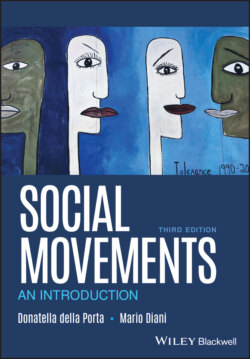Читать книгу Social Movements - Donatella della Porta - Страница 26
2.3.1 Shifting Boundaries between the Public and the Private
ОглавлениеIn the past, the expansion of the role of the state has contributed to the modification of the boundaries between the public and the private. The state has intervened with growing frequency in areas relating to private life, in particular, through the provision of social services and the action of welfare agencies. The principal form of support offered to citizens has been, however, accompanied by increased control over aspects of life that previously would have been left to the autonomous regulation of social actors. The extension of the public health service, for example, has favored the standardization of therapeutic methods and the treatment of crucial events in the experience of individuals, such as maternity. A tendency toward the bureaucratization and rationalization of the private sphere has followed (Habermas 1976, 1987; Melucci 1989, 1996).
In this way, definitions of criteria for determining normality and deviance in areas that were previously left to the regulation of other institutions (such as the church or the family) have become the object of public intervention. Thus, the premises have been created for the rise of new conflicts whose protagonists are social groups – for example, professionals and users of social services, or managers with responsibility for the coordination and running of public agencies (Hoffman 1989). In many cases, protest has related not only to the efficiency of services but also to their impersonality and their tendency to create and reproduce deviance and marginality instead of combating them. Similar concerns are expressed by movements that criticize private groups of professionals (for example, certain sectors of the medical establishment, pharmaceutical companies, and so on) accused of subordinating care for service users to organizational and economic logics (J. Gamson 1989; Crossley 2006).
In the industrial society, a (relatively) clear distinction between public and private allowed people to define citizenship rights as a complex of civil opportunities (relating, for example, to freedom of expression and association), political opportunities (relating to the right to vote, for example), and social benefits (relating to access to minimum levels of well‐being and education) without any further qualifications (Marshall 1992). These rights, in fact, referred to the citizen as understood generically – usually male, adult, Western. Mobilization aimed at extending rights of citizenship entailed provision of the same set of entitlements to social groups that had been excluded: illiterate and nonaffluent people, but also women and ethnic minorities (Barbalet 1988).
Toward the end of the twentieth century, however, various factors have revealed the problematic nature of this notion of citizenship. Not only has it been pointed out how Marshall’s model was hardly applicable in countries other than Britain (Giddens 1983; Barbalet 1988), but also a series of structural processes have undermined previously taken‐for‐granted understandings. With the consolidation of the presence of women in the public sphere (in both professional and political terms), the contradiction has become clear between rights formally recognized as universal, and existing forms of organization of family and professional life that have restricted women’s enjoyment of those rights. Immigration waves to Western countries have made the problem more urgent of how to articulate citizens’ rights in such a way as to allow for the existence of different cultural groups. Particularly, the growing number of non‐national residents pushed for an adaptation of the very notion of citizenship rights, with the effects of various degrees of protection for different “shades” of citizenship (Soysal 1994; Isin and Turner 2002; della Porta 2018c).
All these examples suggest that, although the nation‐state and modern citizenship rights took their inspiration from universal identities, other possible sources of collective identity and of conflict have not disappeared. Other criteria based on traits such as gender, ethnic origin, or age regularly appear alongside those of a functionalist or universal type, to define collective actors. In consequence, citizenship appears to be less a set of endowments and more a process of a conflicting nature, where what is at stake are the criteria defining what a citizen is. The fact that the state has widened its scope for intervention only makes the political nature of those asymmetries and inequalities more obvious.
